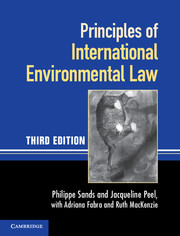Book contents
- Frontmatter
- Contents
- Foreword
- Preface and acknowledgments to the first edition
- Preface and acknowledgments to the second edition
- Preface and acknowledgments to the third edition
- Table of cases
- Table of treaties and other international instruments
- Abbreviations
- Part I The legal and institutional framework
- Part II Principles and rules establishing standards
- Part III Techniques for implementing international principles and rules
- 14 Environmental impact assessment
- 15 Environmental information
- 16 Financial resources, technology transfer and intellectual property
- 17 Liability for environmental damage
- Part IV Linkage of international environmental law and other areas of international law
- Index
- References
15 - Environmental information
from Part III - Techniques for implementing international principles and rules
Published online by Cambridge University Press: 05 June 2012
- Frontmatter
- Contents
- Foreword
- Preface and acknowledgments to the first edition
- Preface and acknowledgments to the second edition
- Preface and acknowledgments to the third edition
- Table of cases
- Table of treaties and other international instruments
- Abbreviations
- Part I The legal and institutional framework
- Part II Principles and rules establishing standards
- Part III Techniques for implementing international principles and rules
- 14 Environmental impact assessment
- 15 Environmental information
- 16 Financial resources, technology transfer and intellectual property
- 17 Liability for environmental damage
- Part IV Linkage of international environmental law and other areas of international law
- Index
- References
Summary
INTRODUCTION
Improving the availability of information on the state of the environment and on activities that have adverse or damaging effects are well-established objectives of international environmental law. Information, including scientific expertise, is widely recognised as a prerequisite to effective national and international environmental management, protection and co-operation. The availability of, and access to, information allows preventative and mitigation measures to be taken, ensures the participation of citizens in national decision-making processes, and can influence individual, consumer and corporate behaviour. Information also allows the international community to determine whether states are complying with their legal obligations. These themes were picked up by the International Court of Justice in the Pulp Mills case, as noted below.
Legal obligations developed with early treaty provisions requiring parties to provide information to the depository, or to other parties, on measures to implement commitments. Since then, environmental information has gradually emerged as a central issue of international environmental law. Principle 2 of the 1972 Stockholm Declaration called for the ‘free flow of up-to-date scientific information and transfer of experience’. The 1982 World Charter for Nature broadened the scope and extent of obligations relating to information, calling for the dissemination of knowledge of research, the monitoring of natural processes and ecosystems, and the participation of all persons in the formulation of decisions of direct concern to the environment. During the 1980s, a number of treaties emerged addressing public education, information exchange and consultation. The Seveso accident in 1982 and the Chernobyl accident in 1986 focused attention on the need to improve the provision of information in emergency situations and, towards the end of the 1980s, eco-labelling and corporate environmental auditing and accounting had become issues addressed by law at the international level.
- Type
- Chapter
- Information
- Principles of International Environmental Law , pp. 624 - 664Publisher: Cambridge University PressPrint publication year: 2012



